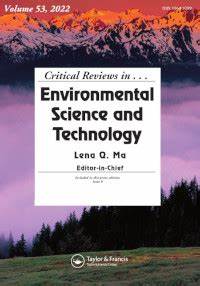Review on age-specific exposure to organophosphate esters: Multiple exposure pathways and microenvironments
IF 11.4
1区 环境科学与生态学
Q1 ENVIRONMENTAL SCIENCES
Critical Reviews in Environmental Science and Technology
Pub Date : 2022-06-22
DOI:10.1080/10643389.2022.2087428
引用次数: 9
Abstract
Abstract Organophosphate esters (OPEs) widely exist in the environment, raising increasing concerns about their potential health risks. This comprehensive review surveyed the occurrence of OPEs over the last decade in indoor microenvironments (i.e. residence, in-vehicle, office, and school/daycare center), outdoors, foodstuffs, drinking water, and human-related specimen (i.e. breast milk and urine) with a view to unraveling age-specific exposure to OPEs. Multiple exposure pathways including inhalation, dermal absorption, dust ingestion, and dietary ingestion were considered to prioritize their relative importance. The results showed that dietary ingestion was the main contributor, followed by dust ingestion, regardless of age. A healthy diet with less contaminated food can effectively reduce OPE intake. OPE concentrations in air and dust followed the sequence of in-vehicle and office > school/daycare center > residence > outdoors. Compared to other indoor settings, exposure in schools/daycare centers and offices contributed to a greater OPE intake in non-adults and adults, respectively. The estimated daily intake of OPEs followed the sequence of infants > toddlers > children > teenagers > adults > elderlies. Overall, OPEs posed low health risks to all age cohorts, but infants were vulnerable and subject to the highest risk, largely attributed to breast milk ingestion. This review highlights the need for more toxicity and bioaccessibility studies on OPE mixtures and metabolites to further refine the health risk assessment of OPEs. Graphical abstract特定年龄有机磷酸酯暴露研究综述:多种暴露途径和微环境
有机磷酸酯(OPEs)广泛存在于环境中,其潜在的健康风险日益引起人们的关注。这项综合综述调查了过去十年室内微环境(即住宅、车内、办公室和学校/日托中心)、户外、食品、饮用水和与人类相关的标本(即母乳和尿液)中OPEs的发生情况,以期揭示年龄特异性暴露于OPEs。多重暴露途径包括吸入、皮肤吸收、灰尘摄入和饮食摄入被认为是优先考虑的相对重要性。结果表明,饮食摄入是主要因素,其次是灰尘摄入,与年龄无关。少污染食物的健康饮食可以有效减少OPE的摄入。空气和粉尘中的OPE浓度顺序为车内和办公室>学校/日托中心>住宅>户外。与其他室内环境相比,暴露在学校/日托中心和办公室分别导致非成人和成人更大的OPE摄入量。估计每日摄入的OPEs的顺序为:婴儿bb0幼儿bb1儿童bb2青少年bb3成人bb4老年人。总体而言,外泄对所有年龄组的健康风险都很低,但婴儿易受伤害,风险最高,这主要归因于母乳摄入。这篇综述强调了需要进行更多的关于环氧乙烷混合物和代谢物的毒性和生物可及性研究,以进一步完善环氧乙烷的健康风险评估。图形抽象
本文章由计算机程序翻译,如有差异,请以英文原文为准。
求助全文
约1分钟内获得全文
求助全文
来源期刊
CiteScore
27.30
自引率
1.60%
发文量
64
审稿时长
2 months
期刊介绍:
Two of the most pressing global challenges of our era involve understanding and addressing the multitude of environmental problems we face. In order to tackle them effectively, it is essential to devise logical strategies and methods for their control. Critical Reviews in Environmental Science and Technology serves as a valuable international platform for the comprehensive assessment of current knowledge across a wide range of environmental science topics.
Environmental science is a field that encompasses the intricate and fluid interactions between various scientific disciplines. These include earth and agricultural sciences, chemistry, biology, medicine, and engineering. Furthermore, new disciplines such as environmental toxicology and risk assessment have emerged in response to the increasing complexity of environmental challenges.
The purpose of Critical Reviews in Environmental Science and Technology is to provide a space for critical analysis and evaluation of existing knowledge in environmental science. By doing so, it encourages the advancement of our understanding and the development of effective solutions. This journal plays a crucial role in fostering international cooperation and collaboration in addressing the pressing environmental issues of our time.

 求助内容:
求助内容: 应助结果提醒方式:
应助结果提醒方式:


